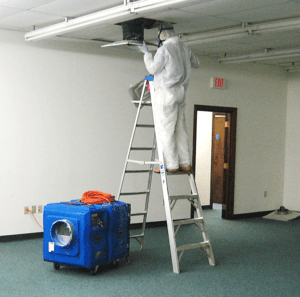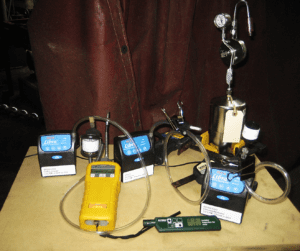Testing for indoor air pollutants
 Do you suspect an issue with the quality of the air in your building? Are you unsure of how the air should be tested? Indoor air quality can have a significant impact upon the health and productivity of the occupants of residential, commercial, institutional, and industrial buildings. Addressing air quality concerns before they become problematic is essential to maintain—and improve—the health of a building and its occupants.
Do you suspect an issue with the quality of the air in your building? Are you unsure of how the air should be tested? Indoor air quality can have a significant impact upon the health and productivity of the occupants of residential, commercial, institutional, and industrial buildings. Addressing air quality concerns before they become problematic is essential to maintain—and improve—the health of a building and its occupants.
The best way to determine air quality in a building is to have the air tested. Methods of testing indoor air quality can vary depending upon the substance of concern. The three most common types of indoor air quality concerns include radon, mold, and Volatile Organic Compounds.
In this article we will discuss each of these indoor air quality concerns and the testing methods specific to each substance.
Radon
Radon is a carcinogenic, radioactive gas. It is unable to be seen, smelled, or tasted. The source of radon is naturally occurring and is produced as a daughter product of radioactive decay associated with radium and uranium deposits. It can migrate into structures via basements, crawl spaces, cracks in foundation slabs, and/or preferential pathways created by utility perforations in slab on grade structures. The EPA’s recommended action level is four picocuries per liter (or 4 pCi/L).
Radon test kits are available from many sources. Digital radon detectors are commercially available and can provide data-logging features that allow for the observation of possible trends during periods of higher ventilation rates of the indoor structures, or even during periods of changing weather conditions such as when barometric pressure is rising or falling. Single-use test kits are readily available from laboratories that include radon testing in their repertoire of analytics.
If deploying a radon single-use test kit, be prepared to allow it to remain deployed over the course of several days in the lowest-lying area of the building—the first floor, the basement, and/or a crawl space of the structure. It is important to ventilate the test area while the kit is deployed.
Mold
Both active and dead mold spores can significantly impact indoor air quality. Mold can hide behind drywall, under carpet, or in the attic. There is no specific EPA air concentration standard for mold. People vary in their sensitivity to specific types and amounts of mold spores. Sensitivity often increases with repeated exposure. Most people are particularly sensitive to the species known as Stachybotrys chartarum, a black “toxic” mold.
Most mold outbreaks are the result of indoor environments that have been the victim of water damage. Water damage can refer to flooding that has occurred due to improperly sealed or drained foundations, water heater ruptures, roof leaks, and even water drips from pipes due to condensation within drop ceilings and crawl spaces.
Since there are no Federal or state standards for mold concentration, indoor air quality assessors will collect indoor and outdoor air samples for comparison. If individual mold spore species are identified and enumerated by the microbiology laboratory to be at higher concentrations in the indoor samples than the outdoor samples, the results may indicate that mold is actively growing within the building.
To collect air samples for mold testing, air sampling cassettes are attached to portable battery-operated air sampling pumps. Once attached, a known volume of air is drawn through the sampling cassette. Known volumes of air are calculated by calibrating each sampling pump with the use of a flowmeter and programming a sample time duration to the air pump.
sampling pumps. Once attached, a known volume of air is drawn through the sampling cassette. Known volumes of air are calculated by calibrating each sampling pump with the use of a flowmeter and programming a sample time duration to the air pump.
When sampling indoor air for the presence of mold spores, it is imperative that the IAQ assessor collect enough samples from within the indoor environment to properly assess the area of concern, as well as background samples that are collected from the outdoor environment. Background samples must be collected on the same day as the indoor samples to represent background conditions during the survey. EMS typically recommends a minimum of five air samples be collected from the indoor environment, even in small single-story residential homes.
If any mold abatement is conducted, post-abatement sampling should also be conducted to determine if remediation was successful. Post-abatement sampling should occur at similar locations to any pre-abatement samples that were collected.
In mold abatement projects, it is important to first completely understand the source of moisture that is driving the exacerbation of mold spores and correct it. If the source of moisture is not identified and corrected, abatement actions will be futile as mold growth will reoccur.
Volatile Organic Compounds
Volatile Organic Compounds (VOCs) encompass a large range of chemicals and are found in many products that are used on a daily basis. VOCs include petroleum-based products, solvents, cleaners, and degreasers.
One of the largest sources of VOCs today is fuels such as gasoline, diesel, heating oil, and kerosene. Sources of indoor air quality degradation related to fuels can be your structure’s HVAC system (especially if it is located near an exhaust source), underground storage tanks utilized as heating or boiler utilities, leaky fuel delivery lines, improperly-functioning furnaces, industrial chemicals, and cleaning products.
Primary methods utilized when attempting to identify possible sources of VOCs include indoor air sampling, soil gas sampling around the outside of a building and/or sub-slab vapor sampling to identify if vapor intrusion is occurring from a subsurface source. If sub-slab vapor sampling is performed it is highly recommended that concurrent indoor air sampling also be conducted to differentiate indoor sources from exterior or sub- slab sources.
In recent years, vapor intrusion has become more and more prevalent in the realm of indoor air quality. Vapor intrusion implies the intrusion of VOC vapors into structures from outside sources, including subsurface sources. Subsurface sources of VOC vapors may include nearby underground storage tanks that have leaked petroleum product into the surrounding soil and groundwater. Another large source—and primary concern for vapor intrusion—are chlorinated solvents such as PCE and TCE of ten used for dry cleaning and industrial uses. There have been many documented occasions of vapors volatilizing enough out of the groundwater, up through the vadose zone, and into structures through preferential pathways such as cracks in the foundation slab, utility perforations, or through the floor in the case of a crawl space. Appropriate sampling methods and sampling analysis based upon required sample type:
Soil Gas Sampling vs. Indoor Air Sampling
Independent air quality screening levels are employed for soil gas samples versus indoor air samples. Sub-slab and exterior soil gas samples are compared to Soil Gas Screening Levels (SGSLs) and indoor air sampling results are compared to Indoor Air Screening Levels (IASLs). Each stand-alone set of screening levels has individual thresholds for all constituents of concern within the above described analytical methods’ analyte lists. If published screening levels are NOT exceeded, typically no further investigation is needed as the Vapor Intrusion pathway is considered incomplete. However, if exterior soil gas sampling results exceed SGSLs, it is typically recommended that sub-slab soil gas sampling be completed to further evaluate the potential for a Vapor Intrusion pathway. Further, if sub-slab soil gas sampling indicates exceedance of the SGSLs, than additional indoor air quality sampling is recommended if it is not being conducted concurrently. Screening levels are always subject to change, so it is prudent to check with your regulatory authority’s website to ensure you are comparing your results to the most current available data.
Soil gas sampling is typically completed using either permanent or temporary expendable sampling points that are driven into a desired sampling depth. The expendable sample points are connected to nylon or Teflon tubing that extends to the surface for the facilitation of sample collection. Sample personnel must ensure an airtight seal around the sampling points to provide for samples that are representative of subsurface conditions without background interference. Leak testing must be conducted prior to collecting soil gas testing.
Sample Collection Methods
PID/FID
Photoionization Detectors (PIDs) and Flame Ionization Detectors (FIDs) are hand held meters used to obtain a qualitative indication of the presence of VOCs. These types of instruments are not sensitive to all types of chemicals and it is up to the indoor air quality assessor to choose the proper equipment based upon site specific requirements.
Summa Canisters
Summa canisters are stainless steel vessels used to collect air samples over a specific time interval. Summa canisters are provided by a laboratory and shipped under negative pressure (vacuum). Each Summa canister  is equipped with a vacuum gauge that is to be matched with its paired canister. The IAQ assessor adjusts the vacuum gauge and valves to allow for the appropriate volume of air to be sampled over a specified period of time. When sampling for VOCs in indoor air, Summa canisters are deployed within the area of concern, as well as within the background areas outside the areas of concern. The IAQ assessor must ensure, prior to deploying each canister, that when the vacuum gauge is attached, the same vacuum logged by the laboratory prior to shipment is still the vacuum read on the gauge. This ensures that no vacuum has been lost by the canister. If the vacuum readings don’t match, it would indicate a vacuum loss, which equates to a compromised and non-viable sample canister. Once all sampling containers are determined to be viable, they may be deployed. Summa canisters can be pre-shipped with a range of vacuums and flow rates, although samples are commonly collected over an eight-hour period. Post-sampling vacuum gauge readings should read nearly zero, indicating the entire sample was collected.
is equipped with a vacuum gauge that is to be matched with its paired canister. The IAQ assessor adjusts the vacuum gauge and valves to allow for the appropriate volume of air to be sampled over a specified period of time. When sampling for VOCs in indoor air, Summa canisters are deployed within the area of concern, as well as within the background areas outside the areas of concern. The IAQ assessor must ensure, prior to deploying each canister, that when the vacuum gauge is attached, the same vacuum logged by the laboratory prior to shipment is still the vacuum read on the gauge. This ensures that no vacuum has been lost by the canister. If the vacuum readings don’t match, it would indicate a vacuum loss, which equates to a compromised and non-viable sample canister. Once all sampling containers are determined to be viable, they may be deployed. Summa canisters can be pre-shipped with a range of vacuums and flow rates, although samples are commonly collected over an eight-hour period. Post-sampling vacuum gauge readings should read nearly zero, indicating the entire sample was collected.
Soil gas samples collected within Summa canisters are typically analyzed by EPA Method TO-15.
Tedlar Bags and Airtight Syringes
Additional sample collection devices include Tedlar bags and glass or Teflon-lined airtight syringes. If bags or syringes are utilized as your primary sample collection device, the samples should be analyzed by an onsite mobile laboratory due to three-hour hold times typically associated with those collection devices.
If sampling with bags or syringes, field lab analysis is commonly performed by EPA Method 8260B or EPA Method TO-14.
The experts at EMS are always prepared to answer any questions and help with any indoor air quality concerns you may have about your home or your business. Please contact us to get in touch with one of our professionals!
If you are experiencing health concerns that cannot be attributed to seasonal allergies or the common cold, check out this article to learn more about how indoor air pollutants may be affecting your health.



Wow, I had no idea that there were so many different pollutants that could be found in the air around the home. I can definitely see why it would be important to properly test for them then. Of course, if you did discover a pollutant you’d definitely want to consult with someone on how to get rid of it.